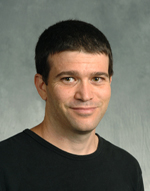Amos Tanay
 We work toward a coherent framework that fuses experimental evidence on
genome function and data on the divergence of genomes between species.
Genome function and divergence are inherently coupled by the evolutionary
process: divergence is constrained at loci with critical functions and
function emerges through divergence that leads to successful adaptation.
We thus pursue an integrative approach to study the functional and
evolutionary aspects of some practical biological questions while developing
a basic theory to support their synthesis:
We work toward a coherent framework that fuses experimental evidence on
genome function and data on the divergence of genomes between species.
Genome function and divergence are inherently coupled by the evolutionary
process: divergence is constrained at loci with critical functions and
function emerges through divergence that leads to successful adaptation.
We thus pursue an integrative approach to study the functional and
evolutionary aspects of some practical biological questions while developing
a basic theory to support their synthesis:
(1) Gene regulation. Genomes control their own activity by adapting the potential of genomic loci to bind proteins and sustain them. We study gene regulation by modeling together the divergence of DNA sequences at control loci and experiments that measure DNA-protein interactions and chromatin structure (2) Epigenetics and cancer. Cells are using layers of extra-genomic (epigenetic) information, encoded as biochemical modifications to Chromatin and DNA, to organize genomic activity and to make sure only needed instructions are performed. These mechanisms are altered in cancer, giving rise to aberrant gene activity. We combine evolutionary models and biological experiments to characterize the function of epigenetic modifications through the prism of species evolution and in the context of microevolution in populations of cancer cells. (3) Theoretical foundations. We develop mathematical models and computational tools to study stochastic evolutionary processes in regions with complex functions that involve interaction among proximal and remote loci (epistasis).
Recent Publications
- [with Ann O'Donnell, Marc Damelin and Tim Bestor] Hyperconserved CpG domains underlie Polycomb-binding sites. Proc. Natl. Acad. Sci. USA. 104: 13 (2007) 5521-6.
- Extensive low-affinity transcriptional interactions in the yeast genome. Genome Research 16: 8 (2006) 962-72.
- [with Aviv Regev and Ron Shamir] Conservation and evolvability in regulatory networks: the evolution of ribosomal regulation in yeast. Proc. Natl. Acad. Sci. USA 102: 20 (2005) 7203-8.

